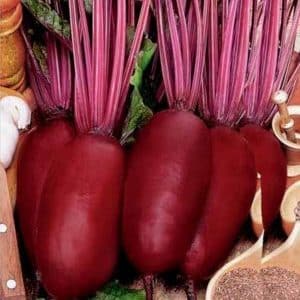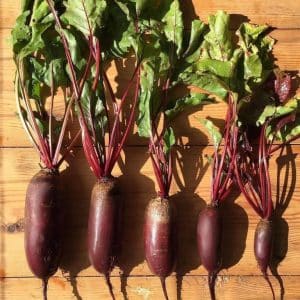Favorite by farmers for its ease of care and taste, the Cylinder beet variety
Cylinder beets - one of the most popular varieties for cultivation on farms and in personal plots. Easy care, always high yields, delicate sweet taste of fruits and excellent preservation - all this is about the Cylinder variety.
Description of the variety
The Cylinder beet variety was developed by Dutch breeders. Included in the Russian State Register and recommended for growing in any region.
The variety has its own characteristics: Cylinder is a heat-loving crop. It is not recommended for early planting, since at temperatures below 5 °C many young shoots die, and those that survive go into flowering without setting root crops.
Distinctive features

Low frost resistance determines the seedling method of sowing in the northern regions of Russia. In the southern regions, sowing directly into the ground is possible as soon as the temperature at night stops falling below 5 °C.
The variety does not tolerate shade well; the crop should be sown in open sunny areas. In case of insufficient lighting, root crops do not set well and tops grow.
Cylinder beets require increased attention to the soil. It grows best on peat bogs, chernozems, sandy loam and loamy soils. The last 2 types of soil require additional application of compost in the fall to the bed where it is planned to grow beets.
Attention! Beets do not tolerate the application of fresh manure.It is worth choosing a place for beets taking into account the fact that manure was applied to the garden bed no later than 2 seasons ago.
Fruit characteristics, yield
Cylinder has a characteristic appearance of the fruit: elongated, cylindrical, up to 7-9 cm thick, dark burgundy in color. When cut, the pulp has a uniform, dark, rich color. The average length of root crops is about 17 cm. The weight of the fruit is 300-550 g.
Root vegetables are juicy. They have a thin peel, but are well stored. The taste qualities of the cylinders are highly rated by experts: the flesh is soft and sweet.
The yield of Cylinder beets is on average 10 kg per 1 m², but if you take good care of the vegetable, you can achieve a volume of 11-12 kg.
How to grow
Cylinder beets are grown by seedlings or seeds, depending on the region of planting. In the northern regions, seedlings are used so as not to lose the harvest due to the first autumn frosts.
Planting by seeds
Sowing Cylinder beets directly into the ground is recommended no earlier than the 20th of May for the central regions of the Russian Federation; for the northern regions, the planting schedule should be shifted by another 7-10 days.
Basic Rules:
- seed placement depth no more than 3 cm;
- distance between seeds 2-3 cm;
- distance between rows 20-30 cm;
- before sowing, the seeds can be briefly treated with trichodermin or soaked in “Kornevin”;
- after the appearance of 2-3 permanent leaves seedlings should be thinned out - the distance between plants should be at least 6-8 cm.
Planting seedlings
It makes sense to grow the Cylinder variety through seedlings in the northern regions of Russia or in the central regions (to obtain an early harvest):
- seedlings are sown in containers with a soil depth of at least 10-13 cm;
- It is better to place containers in a greenhouse;

- if sowing is carried out in early April, additionally cover with glass;
- seeds are soaked in Kornevin solution before planting;
- seeds are planted to a depth of 2-3 cm in loose soil, the distance between seeds is 2-3 cm;
- watering carried out no more than once a week, strictly control the soil moisture;
- after the first permanent leaf appears, the glass is removed from the container;
- The seedlings are planted in a permanent place in mid-May - they try to capture the soil as deeply as possible so as not to injure the beet root system (if the roots are injured, the formation of an elongated root crop may be disrupted).
Beet care Cylinder
Basic care for beets of the Cylinder variety is non-specific. Water this crop regularly, but moderately. The variety does not tolerate waterlogging and stagnation of water.
Thinning is carried out twice per season: the first time when the 3rd permanent leaf appears, then after 3-4 weeks as needed. The main task of thinning is to leave a distance of at least 6 cm between plants for the full development of root crops.
Weeding and loosening are required for the Cylinder variety. Beets are demanding of loose soil. It is advisable to carry out loosening after each watering to prevent the formation of a dense earthen crust. Weeding is carried out as necessary.
Wide row spacing is mulched to retain moisture in the soil.. Mulching will also allow you to avoid regular loosening - the soil does not bake or compact.
It is not necessary to apply fertilizer for Cylinder beets if the bed has been prepared correctly.However, the crop can be improved by applying ash once per season, as well as treating the crops with a solution of boric acid, which works as an antifungal agent and will prevent major diseases.
Attention! Beets should not be fed with organic fertilizers, nor should they be watered with a solution of bird droppings. All growth with such feeding will go into the tops.
Features of cultivation
Farmers and summer residents noticed that most of the root crops are located above the ground. This leads to coarsening of the peel and compaction of the pulp in the upper part, as well as cracking of root vegetables.
The main reason for this growth is insufficient soil looseness. Is it worth closing hilling A cylinder that grows root side up? There is no definite answer here: you can lightly rake the soil towards the roots when loosening, but beets do not require high-quality hilling.
Diseases and pests
The Cylinder variety is highly resistant to diseases. If agricultural practices are violated, especially the irrigation regime, beets may be affected by:
- brown rot;

- black leg;
- downy mildew;
- Phomasis.
The most dangerous pests for beets are:
- flea beetles;
- beet flies;
- aphid;
- shieldweed;
- Root vegetables can be eaten by mole crickets.
Intavir tablets work well against most insects, but mole crickets will have to be fought mechanically and with special preparations (Thunder).
Harvesting and application
Cylinder belongs to mid-season varieties. The technical maturity of root crops occurs 120-130 days after sowing - in September. Beetroot is harvested in clear, sunny weather, and the root crops are thoroughly dried before storing.
Store beets It is better to place the cylinder in boxes in 2 layers, sprinkling the layers with sand. The optimal storage temperature is 4-5 °C; The boxes are left in a dark room with moderate humidity. Under such conditions, root vegetables will retain their marketable appearance and nutritional value for 5-6 months.
Advantages and disadvantages of the variety
The advantages made Cylinder one of the most popular varieties in Russia:
- ease of care;

- easy sowing through seedlings;
- economical - more root crops grow in the garden thanks to the elongated shape of the beets;
- drought resistance;
- pleasant sweetish taste;
- thin skin of root vegetables;
- long-term storage of beets;
- The variety is resistant to most diseases.
The disadvantages of the variety are associated with the European origin of the crop:
- The cylinder is poorly resistant to frost;
- the yield of products decreases when sowing early in the ground, since the plants do not set roots, but go into bloom if the air temperature at night drops below 5 ° C;
- ripening period - autumn, the variety is not suitable for early harvest;
- The variety is not suitable for cultivation on acidic soils.
Farmer reviews
We bring to your attention reviews from summer residents who have already cultivated this variety.
Kirill, Moscow region: “I’ve been growing Cylindra for the last 5 years, and I always get decent results. They are purchased by both wholesalers and farm supply stores. Tsilindra's root vegetables are smooth, neat, very attractive, and the taste is incomparable! I manage to sell the entire harvest before the New Year holidays.”
Maria, Kaluga: “We grow Cilindra as the most productive beet variety, we get up to 11 kg per meter. But beets are very demanding on soil looseness, so there is constant weeding and loosening.But Cylinder practically doesn’t have to be watered; there is enough rainfall for her.”
Olga, Saratov: “I’ve been planting Cylinder for about 7 years, if not more. We eat as a family and sell a lot. They already know us at the market and always ask for Cilindra - people like the taste of this beet: sweet, juicy, you won’t find anything like it in stores. Until spring, the harvest lies in the cellar without problems - it does not wrinkle, does not dry out, and in April the beets are as sweet as in September when harvested.”
Conclusion
Cylinder beets do not require special care, are compactly placed in beds and therefore are successfully used for growing on an industrial scale. Low spring temperatures become a limitation for planting beets, but this problem in the northern regions can be solved by using seedlings and slightly later planting in the ground.